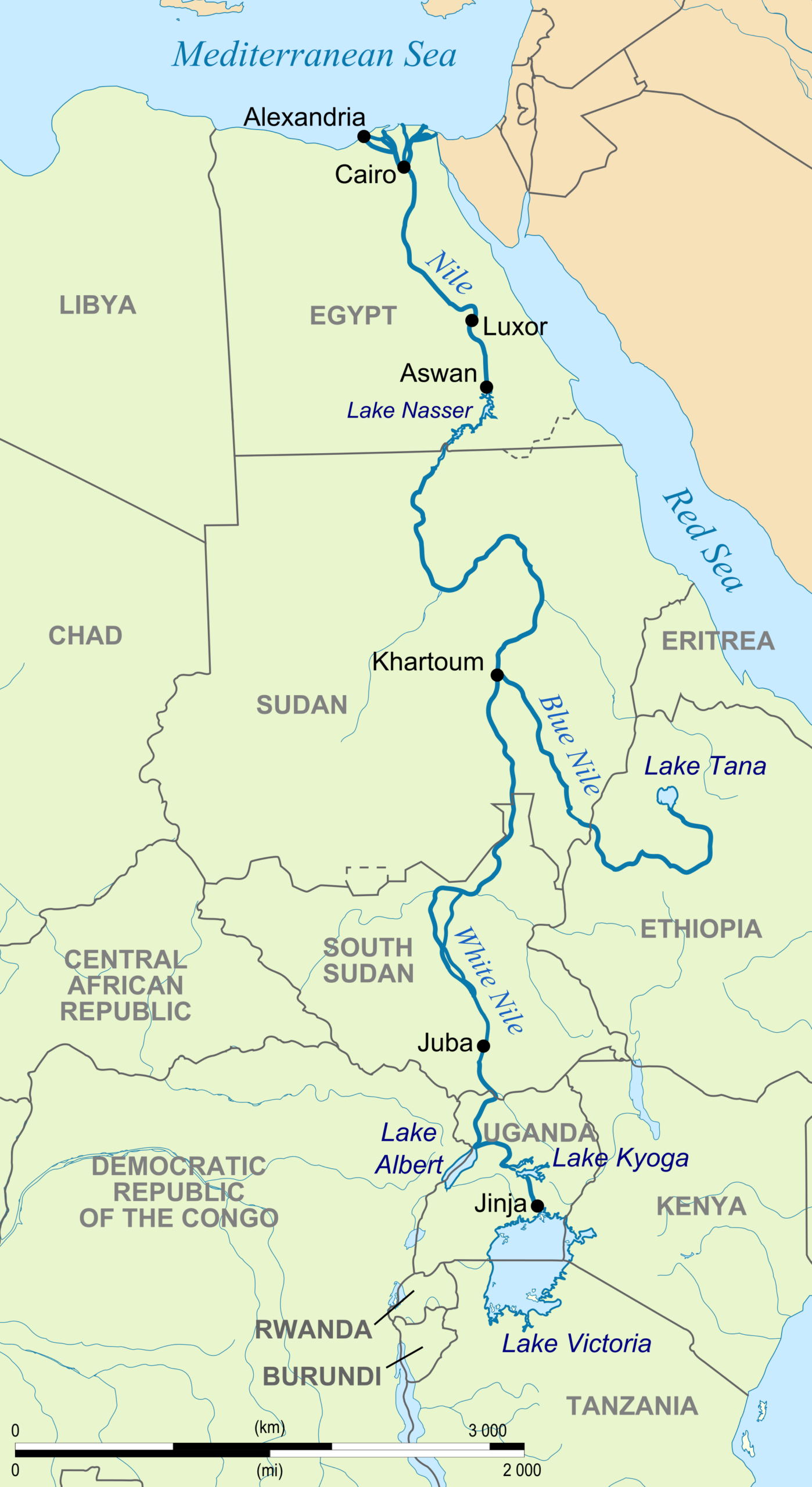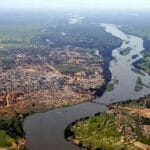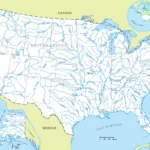Get ready for a wild ride along the Nile, the longest river on Earth! From its mysterious beginnings in Africa to its grand entrance into the Mediterranean Sea, we’ll follow the Nile’s incredible journey. Along the way, we’ll uncover the secrets of how the river was shaped and how it has shaped civilizations for centuries. Get ready to dive into the Nile’s fascinating story, and see how this mighty river has played a starring role in our history.
What Direction Does the Nile River Run?
The Nile River, famous for being the longest river on Earth, stretches an unbelievably long distance. It starts its incredible journey south of the Equator, drawing water from lakes high up in the African Rift Valley. Imagine a river beginning its life so far south, then embarking on a long and winding journey north! That’s the Nile! It flows through the diverse landscapes of northeastern Africa, finally pouring into the Mediterranean Sea.
The Nile doesn’t make this journey alone. Along the way, it’s joined by many other rivers, called tributaries. The Blue Nile and the Atbara River are two of the most important ones, adding their own waters to the Nile’s powerful flow. Over centuries, this river has been a lifeline. It played a crucial role in the rise of ancient Egypt and continues to support countless communities along its banks.
So, what direction does the Nile River actually run? In simple terms, it flows mostly north. Picture the African continent – the land itself gently slopes downward towards the Mediterranean Sea in the north. The Nile follows this natural slope, making its way northwards.
This journey isn’t always easy. The Nile faces challenges like changing water levels depending on the season, sediment buildup, and man-made dams. Yet, despite these obstacles, it remains a vital resource, supporting both people and nature across northeastern Africa.
Discover the intriguing rivers that defy the norm by flowing northward. Explore the what are the rivers that flow north and their unique characteristics.
Unravel the mystery of the Mississippi River’s course by exploring the what direction does the mississippi flow article. Delve into its fascinating journey and discover the factors behind its direction.
Embark on a count of the how many rivers in the united states flow north. Uncover the number of these exceptional waterways that grace the United States and learn about their significance.
Mapping The Journey: Where Does The Nile River Originate And End?
We’ve talked about its importance, but have you ever wondered where exactly the mighty Nile River begins its incredible journey? It’s a tale that unfolds across thousands of miles, starting from a seemingly humble origin to eventually becoming one of the world’s most iconic waterways.
From the Heart of Africa: Unveiling the Nile’s Source
Imagine a map of Africa with its diverse landscapes. The Nile’s journey starts in the eastern part of the continent, a region dotted with the majestic Great Lakes. Among these lakes, the Kagera River, flowing through Rwanda, Burundi, and Tanzania, holds the secret: it’s the furthest point from which the Nile draws its water. Think of it as a vast network of streams and tributaries that eventually converge into Lake Victoria, one of the largest freshwater lakes on the planet. It’s here that the White Nile, the longest tributary of the Nile, begins its northward adventure through Uganda and South Sudan.
A Confluence of Power: Where Two Become One
As the White Nile makes its way through the plains of South Sudan, something incredible happens. Near Khartoum, the bustling capital city of Sudan, it encounters another powerful river: the Blue Nile. This river, originating from Lake Tana in Ethiopia, is known for its dramatic changes in volume depending on the time of year. It’s like two mighty rivers coming together to form an unstoppable force – this union of the White and Blue Niles marks the birth of the Nile River as we know it.
A Journey to the Sea: The Nile’s Final Destination
From Khartoum onwards, the Nile River embarks on its final leg, flowing through Egypt and meandering through the desert before ultimately reaching its final destination: the Mediterranean Sea. This journey through Egypt is what cemented the Nile’s place in history. The ancient Egyptians relied heavily on the Nile’s life-giving waters, using them for everything from agriculture to transportation. To this day, the Nile supports a rich tapestry of life along its banks, nurturing a diverse ecosystem with a wealth of plants and animals.
Challenges and Triumphs: The Nile’s Everlasting Flow
The Nile’s journey isn’t without its challenges. The river’s water levels fluctuate with the seasons, and sediment buildup constantly threatens to alter its course. Dams, while essential for managing water resources, also have an impact on the river’s natural flow. Yet, the Nile persists, a symbol of resilience. Throughout history, people have adapted to these challenges, developing innovative irrigation techniques – from the ingenious methods of ancient Egyptians to the modern engineering marvels we see today – to harness the river’s power and transform barren lands into fertile fields.
The Nile: A River That Flows Through Time
The Nile River’s journey from the Great Lakes region to the Mediterranean Sea is a captivating story of nature’s power and the deep connection between humanity and the environment. Tracing its path allows us to appreciate the geological forces that have shaped our world and the delicate balance of ecosystems that sustain life. The Nile River isn’t just a body of water; it’s a living testament to the enduring force of nature and a source of inspiration for generations to come.
The Nile River’s Northward Flow: Unveiling The Mystery Of Its Reverse Course
We’ve talked about the Nile’s intriguing northward journey, but let’s dive deeper into what makes it so unusual. Imagine a river flowing uphill—that’s essentially what the Nile appears to do! It cuts across Africa, seemingly defying gravity as it heads north towards the Mediterranean Sea. This peculiarity has puzzled experts for ages, sparking numerous theories about its cause.
One early idea was that the Nile simply followed a crack in the Earth’s crust, a rift valley left over from when continents drifted apart. Others suspected the planet’s rotation might be nudging the river off course. However, recent research has painted a clearer picture, and it all comes down to something called “dynamic topography.”
Think of it like this: the Earth’s surface is not static, it’s constantly being reshaped by the slow-motion collision of massive tectonic plates. These plates push and pull, creating mountains and valleys, which in turn influence where rivers flow. It turns out the Nile has been shaped by these forces for over 30 million years!
Studies show that the Nile’s northward path has remained remarkably consistent over this vast period. This suggests that the underlying geological forces responsible for its unusual flow have been remarkably stable as well. It’s a testament to the immense power of plate tectonics and their lasting impact on our planet’s landscapes.
The Nile’s story is far from over. As scientists continue to study its flow, they uncover more details about the complex interplay between geology and the water cycle. Each discovery enhances our understanding not just of the Nile itself, but of how rivers across the globe are shaped by the very ground they flow upon.
How Did Ancient Civilizations Adapt To The Nile’s Direction?
We’ve already talked about how vital the Nile River was, but let’s dive deeper into how its northward flow shaped the lives of those who lived along its banks. Imagine the challenges and opportunities presented by a river that seemed to flow “backwards” compared to many others!
The Nile: More Than Just Water, It Was a Way of Life
For the ancient Egyptians, the Nile wasn’t just a river; it was the backbone of their civilization. Picture this: a seemingly endless ribbon of water, carving its way through the desert, bringing life to everything it touched. Its northward flow was a blessing, carrying fertile silt from the south and depositing it on the land, creating a rich, fertile valley. This annual flooding, anticipated and celebrated, was the heartbeat of Egyptian life, dictating their agricultural cycles and shaping their calendar.
Sailing Against the Current: A Test of Skill and Ingenuity
Here’s where it gets really interesting. The Nile’s northward flow meant that sailing upstream to the south was a real challenge. But the Egyptians were clever; they mastered the art of sailing by harnessing the power of the wind. They invented large sails that caught the prevailing winds blowing south, propelling their boats upstream against the current. This ingenuity opened up the river, allowing them to travel, trade, and communicate along its entire length.
The Nile’s Influence: From Everyday Life to Spiritual Beliefs
The Nile’s northward direction wasn’t just a geographical quirk; it became deeply intertwined with Egyptian culture and beliefs. Think about it: the sun, the giver of life, rose in the east and traveled across the sky to set in the west. The Nile, flowing north towards the Mediterranean, mirrored this celestial journey. This wasn’t a coincidence for the Egyptians; it deepened their reverence for the river. They saw it as a reflection of the heavens, a powerful force connecting the earthly realm with the divine.
This spiritual connection manifested in their religious practices, mythology, and even their burial rituals. Tombs were often located on the west bank of the Nile, symbolically aligning the journey of the deceased with the setting sun, while temples and cities flourished on the east, basking in the light of the rising sun.
The Nile’s northward flow wasn’t simply a geographical feature; it was a defining element of ancient Egyptian civilization, shaping their daily lives, their beliefs, and their legacy.
FAQ
Q1: Which direction does the Nile River flow?
A1: The Nile River flows northward from its source in the Great Lakes region of Central Africa to its mouth at the Mediterranean Sea.
Q2: What is the length of the Nile River?
A2: The Nile River is the longest river in the world, stretching over 6,600 kilometers (4,100 miles) from its source to its delta.
Q3: Through which countries does the Nile River flow?
A3: The Nile River flows through eleven countries: Tanzania, Uganda, Rwanda, Burundi, the Democratic Republic of the Congo, Kenya, Ethiopia, South Sudan, Sudan, Egypt, and Eritrea.
Q4: What is the significance of the Nile River to Egypt?
A4: The Nile River has been crucial to the development of Egyptian civilization for thousands of years. Its fertile floodplains have supported agriculture, and its waters have provided drinking water, irrigation, and transportation.
Q5: What are the major tributaries of the Nile River?
A5: The major tributaries of the Nile River include the White Nile, the Blue Nile, the Atbara River, and the Sobat River. The White Nile is the longest tributary, and the Blue Nile contributes the most water to the main river.
- China II Review: Delicious Food & Speedy Service - April 17, 2025
- Understand Virginia’s Flag: History & Debate - April 17, 2025
- Explore Long Island’s Map: Unique Regions & Insights - April 17, 2025
















